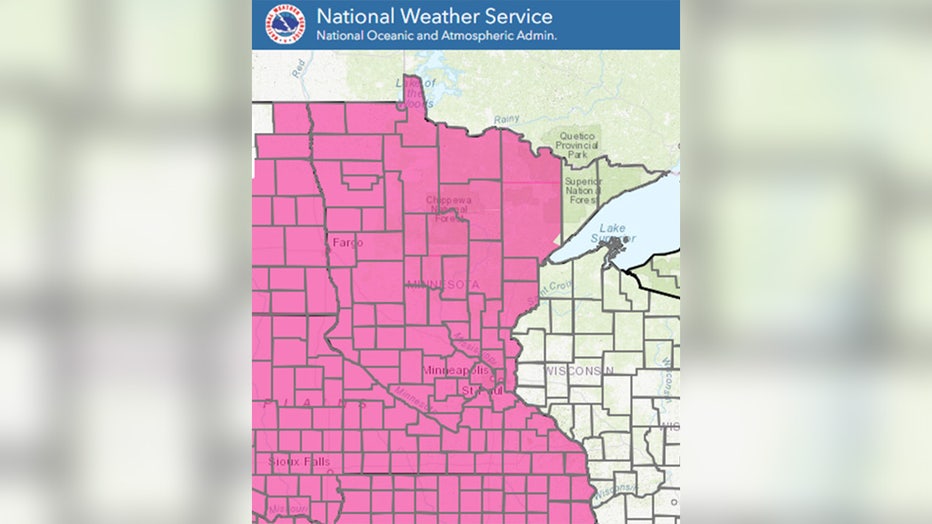Red flag warning: Extreme fire risk for 85 of 87 Minnesota counties

MN weather: Warmer and windy day Thursday
The warming trend continues, with temperatures trying to reach 70 degrees in the Twin Cities metro on Thursday. It will be rather breezy with winds at 15-25+ mph. FOX 9 meteorologist Jared Piepenburg has your forecast.
MINNEAPOLIS (FOX 9) - A red flag warning has been issued on Thursday for most of Minnesota due to an extreme fire risk.
The National Weather Service issued a warning to 85 counties due to "extreme fire danger." The alert states that critical fire conditions are possible across the entire state due to low humidity, very dry conditions, and strong southerly winds.
Which counties are included?

Red flag warning issued for 85 counties in Minnesota on Oct. 17, 2024. (Credit: National Weather Service) (Supplied)
The red flag warning covers every county in Minnesota except Cook and Lake counties in northeast Minnesota. Here is when the warning will take effect:
- The warning in northwest Minnesota from 8 a.m. to 7 p.m. is for the following 18 counties: Becker, Beltrami, Clay, Clearwater, Grant, Hubbard, Kittson, Lake Of The Woods, Mahnomen, Marshall, Norman, Otter Tail, Pennington, Polk, Red Lake, Roseau, Wadena, and Wilkin.
- The warning in central and southern Minnesota from 11 a.m. to 7 p.m. is for the following 58 counties: Anoka, Benton, Big Stone, Blue Earth, Brown, Carver, Chippewa, Chisago, Cottonwood, Dakota, Dodge, Douglas, Faribault, Fillmore, Freeborn, Goodhue, Hennepin, Houston, Isanti, Jackson, Kanabec, Kandiyohi, Lac Qui Parle, Le Sueur, Lincoln, Lyon, Martin, McLeod, Meeker, Mille Lacs, Morrison, Mower, Murray, Nicollet, Nobles, Olmsted, Pipestone, Pope, Ramsey, Redwood, Renville, Rice, Rock, Scott, Sherburne, Sibley, Stearns, Steele, Stevens, Swift, Todd, Traverse, Wabasha, Waseca, Washington, Watonwan, Winona, Wright, and Yellow Medicine.
- The warning for northeast Minnesota from noon to 7 p.m. is for the following eight counties: Aitkin, Carlton, Cass, Crow Wing, Itasca, Koochiching, Pine, and St. Louis.
A special weather statement has also been issued for Cook and Lake counties due to the wind and humidity potentially producing "near-critical fire weather conditions." The statement mentions that outdoor burning is discouraged.
What is a Red Flag warning?
The Minnesota Department of Natural Resources (DNR) said a red flag warning means that "fires can spread quickly and easily progress out of control under the predicted weather conditions, including gusty winds and low relative humidity. Do not burn in counties where a Red Flag Warning is in effect and check any recent burning to ensure the fire is completely out."
When a red flag warning has been issued, the DNR will not issue or activate open burning permits, and campfires are discouraged.
Burning restrictions and fire danger
As of Thursday, the DNR has burn restrictions in place for the entire state. Most of Minnesota is under a no-open-burning restriction, while northeast Minnesota is under an elevated burning restriction, meaning that additional restrictions may be needed based on the current fire danger.
On Wednesday, parts of central and southeastern Minnesota were under burning restrictions that required permits, or agency approved permits only. However, those areas have been upgraded to no open burning allowed. The map showing the change in burning restrictions can be seen below.

The Minnesota DNR burning restrictions map for Oct. 17 (left) and Oct. 16 (right). (Supplied)
On Wednesday, the DNR listed much of Minnesota as having a "very high" fire danger risk, meaning fires can start easily and spread quickly. Sections of southeastern and northwestern Minnesota were at a "high fire risk," while northern Minnesota was at a "moderate" fire risk.
The DNR upgraded much of Minnesota to an "extreme" fire danger risk on Thursday, meaning "the fire situation is explosive and can result in extensive property damage," the website reads. Meanwhile, northeastern Minnesota is a "high" fire danger risk, meaning that a fire can start easily and spread at a fast rate.

The Minnesota DNR fire danger map for Oct. 17 (left) and Oct. 16 (right). (Supplied)
Minnesota drought conditions
Due to the lack of recent rainfall, almost all of Minnesota is suffering from drought. While the state saw a wet spring and summer, September was one of the warmest and driest September ever recorded in Minnesota. September was also the sunniest month in 75 years, and the Twin Cities saw one of the driest growing season days on record.
The Twin Cities metro and areas of southern, central, and northern Minnesota are listed as having "moderate drought" conditions. Areas of northeastern and southwestern Minnesota have "severe drought" conditions, while other areas are experiencing "abnormally dry" conditions or no reported drought conditions.
The Minnesota DNR lists at least 97% of Minnesota as abnormally dry. With no significant rain in the forecast, drought conditions are likely to persist.

Map for drought conditions on Oct. 15, 2024, in Minnesota. (Credit: Minnesota DNR/ National Drought Mitigation Center) (Supplied)

